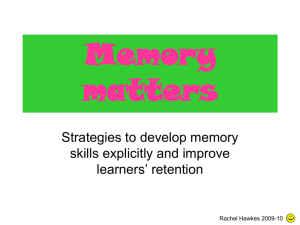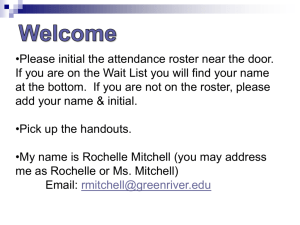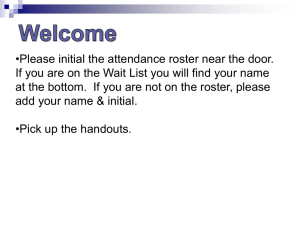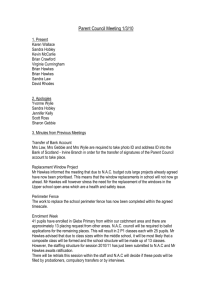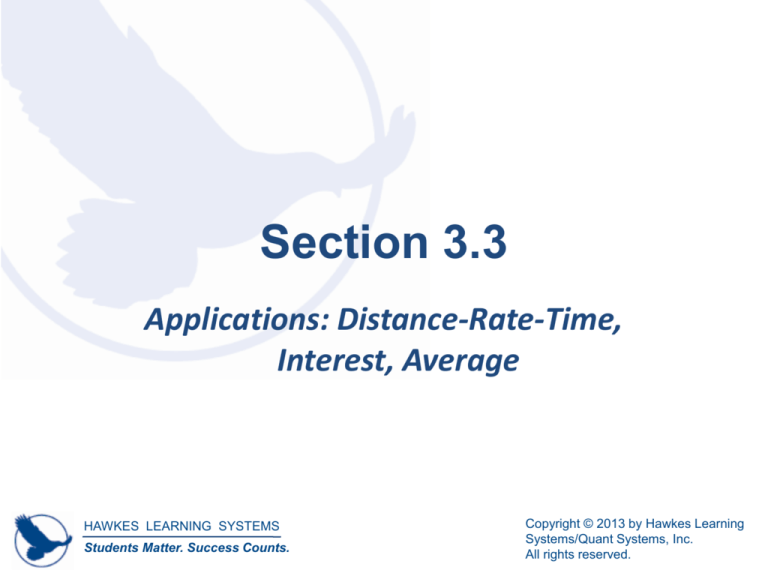
Section 3.3
Applications: Distance-Rate-Time,
Interest, Average
HAWKES LEARNING SYSTEMS
Students Matter. Success Counts.
Copyright © 2013 by Hawkes Learning
Systems/Quant Systems, Inc.
All rights reserved.
Objectives
Solve the following types of problems using linear
equations:
o Distance-rate-time problems,
o Simple interest problems,
o Average problems, and
o Cost problems.
HAWKES LEARNING SYSTEMS
Students Matter. Success Counts.
Copyright © 2013 by Hawkes Learning
Systems/Quant Systems, Inc.
All rights reserved.
Example 1: Distance-Rate-Time
A motorist averaged 45 mph for the first part of a trip
and 54 mph for the last part of the trip. If the total trip
of 303 miles took 6 hours, what was the time for each
part?
Solution
Analysis of strategy:
What is being asked for?
Total time minus time for 1st part of
trip gives time for 2nd part of trip.
HAWKES LEARNING SYSTEMS
Students Matter. Success Counts.
Copyright © 2013 by Hawkes Learning
Systems/Quant Systems, Inc.
All rights reserved.
Example 1: Distance-Rate-Time (cont.)
Let t = time for 1st part of trip
6 − t = time for 2nd part of trip
rate
·
time = distance
1st Part
45
t
45t
2nd Part
54
6–t
54(6 - t)
HAWKES LEARNING SYSTEMS
Students Matter. Success Counts.
Copyright © 2013 by Hawkes Learning
Systems/Quant Systems, Inc.
All rights reserved.
Example 1: Distance-Rate-Time (cont.)
1st part
2nd part
total
distance
distance
distance
45t
+ 54(6 - t) =
HAWKES LEARNING SYSTEMS
Students Matter. Success Counts.
303
Form an equation relating
the given information.
Solve the equation.
Copyright © 2013 by Hawkes Learning
Systems/Quant Systems, Inc.
All rights reserved.
Example 1: Distance-Rate-Time (cont.)
45t 324 - 54t 303
324 - 9t 303
-9t -21
-21 7
t
hr
-9 3
7 11
6 -t 6 -
hr
3 3
HAWKES LEARNING SYSTEMS
Students Matter. Success Counts.
1st part of the trip
2nd part of the trip
Copyright © 2013 by Hawkes Learning
Systems/Quant Systems, Inc.
All rights reserved.
Example 1: Distance-Rate-Time (cont.)
7
Check 45 15 7 105miles (1st part)
3
11
54 18 11 198 miles (2nd part)
3
105 198 303 miles in total
7
1
The first part took hr or 2 hr.
3
3
11
2
The second part took
hr or 3 hr.
3
3
HAWKES LEARNING SYSTEMS
Students Matter. Success Counts.
Copyright © 2013 by Hawkes Learning
Systems/Quant Systems, Inc.
All rights reserved.
Example 2: Interest
Kara has had $40,000 invested for one year, some in a
savings account which paid 7% and the rest in a highrisk stock which yielded 12% for the year. If her interest
income last year was $3550, how much did she have in
the savings account and how much did she invest in the
stock?
Solution
Let
x = amount invested at 7% Total amount invested
minus amount invested at
40,000 − x = amount invested at 12% 7% represents amount
invested at 12%.
HAWKES LEARNING SYSTEMS
Students Matter. Success Counts.
Copyright © 2013 by Hawkes Learning
Systems/Quant Systems, Inc.
All rights reserved.
Example 2: Interest (cont.)
principle · rate =
interest
Savings Account
x
0.07
0.07(x)
Stock
40,000 – x
0.12
0.12(40,000 – x)
interest at 12%
total interest
interest at 7%
0.07 x
0.12 40,000 - x
HAWKES LEARNING SYSTEMS
Students Matter. Success Counts.
3550
Copyright © 2013 by Hawkes Learning
Systems/Quant Systems, Inc.
All rights reserved.
Example 2: Interest (cont.)
7x 12 40,000 - x 355,000
Multiply both sides of the equation
by 100 to eliminate the decimal.
7x 480,000 - 12x 355,000
-5x -125,000
Amount invested at 7%
x 25,000
Amount invested at 12%
40,000 - x 15,000
Check 25,000 0.07 1750 and 15,000 0.12 1800
and $1750 + $1800 = $3550.
Kara had $25,000 in the savings account at 7% interest
and invested $15,000 in the stock at 12% interest.
HAWKES LEARNING SYSTEMS
Students Matter. Success Counts.
Copyright © 2013 by Hawkes Learning
Systems/Quant Systems, Inc.
All rights reserved.
Example 3: Average (or Mean)
Suppose that you have scores of 85, 92, 82 and 88 on
four exams in your English class. What score will you
need on the fifth exam to have an average of 90?
Solution
Let x = your score on the fifth exam.
The sum of all the scores, including the unknown fifth
exam, divided by 5 must equal 90.
HAWKES LEARNING SYSTEMS
Students Matter. Success Counts.
Copyright © 2013 by Hawkes Learning
Systems/Quant Systems, Inc.
All rights reserved.
Example 3: Average (or Mean) (cont.)
85 92 82 88 x
90
5
347 x
90
5
347 x
5
5 90
5
347 x 450
x 103
Assuming that each exam is worth 100 points, you
cannot attain an average of 90 on the five exams.
HAWKES LEARNING SYSTEMS
Students Matter. Success Counts.
Copyright © 2013 by Hawkes Learning
Systems/Quant Systems, Inc.
All rights reserved.
Example 4: Bar Graphs
The bar graph shows the enrollment at the main
campuses at six Big Ten universities. Use the graph to
find the following (note that the units on the graph are
in thousands):
HAWKES LEARNING SYSTEMS
Students Matter. Success Counts.
Copyright © 2013 by Hawkes Learning
Systems/Quant Systems, Inc.
All rights reserved.
Example 4: Bar Graphs (cont.)
a. Find the average enrollment over the six schools.
(Round to the nearest thousand.)
Solution
Find the sum: 42 + 30 + 47 + 15 + 55 + 44 = 233.
Divide by 6: 233 ÷ 6 ≈ 39.
The average enrollment is approximately
39,000 students.
HAWKES LEARNING SYSTEMS
Students Matter. Success Counts.
Copyright © 2013 by Hawkes Learning
Systems/Quant Systems, Inc.
All rights reserved.
Example 4: Bar Graphs (cont.)
b. Which university has the lowest enrollment?
Solution
Northwestern has the lowest enrollment:
15,000 students.
c. Find the difference in enrollment between Ohio
State and Penn State.
Solution
The difference is 55,000 - 44,000 = 11,000 students.
HAWKES LEARNING SYSTEMS
Students Matter. Success Counts.
Copyright © 2013 by Hawkes Learning
Systems/Quant Systems, Inc.
All rights reserved.
Example 5: Cost
A jeweler paid $350 for a ring. He wants to price the
ring for sale so that he can give a 30% discount on the
marked selling price and still make a profit of 20% on
his cost. What should be the marked selling price of
the ring?
Solution
Again, we make use of the relationship
S − C = P (selling price - cost = profit).
HAWKES LEARNING SYSTEMS
Students Matter. Success Counts.
Copyright © 2013 by Hawkes Learning
Systems/Quant Systems, Inc.
All rights reserved.
Example 5: Cost (cont.)
Let x = marked selling price,
then x - 0.30x = actual selling price
and 350 = cost.
actual selling price - cost profit
x - 0.30 x
- 350 0.20 350
0.70 x - 350 70
0.70 x 420
x 600
HAWKES LEARNING SYSTEMS
Students Matter. Success Counts.
The actual selling price is
the marked selling price
minus the 30% discount
on the ring.
The profit is 20% of
what he paid originally.
Copyright © 2013 by Hawkes Learning
Systems/Quant Systems, Inc.
All rights reserved.
Example 5: Cost (cont.)
Check
Step 1:
$600
0.30
$180
marked selling price
discount %
discount
Step 2 :
$600
-$180
$420
HAWKES LEARNING SYSTEMS
Students Matter. Success Counts.
marked selling price
discount
actual selling price
Copyright © 2013 by Hawkes Learning
Systems/Quant Systems, Inc.
All rights reserved.
Example 5: Cost (cont.)
Step 3 :
$420
- $350
$70
actual selling price
cost
profit
As a double check, $350
0.20
cost
profit %
$70 profit
The jeweler should set the selling price at $600.
HAWKES LEARNING SYSTEMS
Students Matter. Success Counts.
Copyright © 2013 by Hawkes Learning
Systems/Quant Systems, Inc.
All rights reserved.

